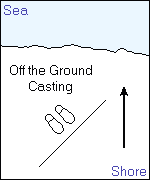Casting
 With the proper rig, rod, and reel, you'd think you'd have the problem handled, but you have to get the bait to the strike zone. Learning to cast well is a must. Beginners should probably start with a basic off the ground cast. You may want to look at my article on Casting as well for more pointers.
With the proper rig, rod, and reel, you'd think you'd have the problem handled, but you have to get the bait to the strike zone. Learning to cast well is a must. Beginners should probably start with a basic off the ground cast. You may want to look at my article on Casting as well for more pointers.
Draw an arrow in the sand that point directly out to sea. Then facing the line with the sea to your left, draw another line that runs back away from the original line at a 45 degree angle toward shore. The key to a power cast is "loading" the rod, or tensing the rod so that it works effectively as a lever. You should feel the tension as the rod is bowed, pulling the weight through for maximum effect. Stand along the 45 degree line, or roughly one quarter turn away from the casting direction. Reach back and lay the sinker on the ground directly in line with the rod tip. Look into the sky in the direction you want the sinker to go, align your rod and look at your bait, then simply pull the rod forward as if it were a spear. When your left hand is comfortably stretched out, pull down with the left and at the same time punch with the right. The two parts should blend smoothly, don't do it in two distinct steps. This cast should reach 70 metres with no effort.
For more power, add body rotation into the mix. Keeping the same stance, start with your back to the sea and rotate your shoulders through the cast, transferring your weight from right to left. Don't speed up ! Keep a steady, fluid motion. The follow through is also important. Keep the rod tip pointed out to sea in the direction of the sinker's flight so that line spools off the reel smoothly. With the added body rotation you should now be reaching distances of 100 metres.
Naturally, depending on whether you are left or right handed, the reverse to the above may apply.
Bait & Presentation
Like all types of fishing, the best bait is whatever is working in the area you're in. Mullet, Shrimp, Crabs, Pilchards - all are possibilities. Your first task is to determine what the fish are feeding on either through observation or asking those in the know.
Presenting the bait is another matter. I'm confident I'm not the only fisherman who has tossed a bait into the sea only to have it end up rolling with the current to a position of not much advantage. The trick may be to practice uptide fishing. Many anglers throw their bait with the tide or straight out from shore, and set the line taut after it's in the water.
A more effective way to present the bait is to walk along the shore about 25 metres uptide from your fishing spot on the beach, then cast into the tide. Walk back to your original spot leaving the line slack and put your rod in its holder or sand. The current's action on the slack line and the prongs on the Breakaway sinker will anchor the rig in place uptide from your position.
Fighting the Fish
When you have a fish on, carefully reel in the slack until you feel the fish and give a good tug to make sure the hook is well set. The fish will follow the path of least resistance and probably run with the tide. To make your job easier, try to stay in front of the fish. If the fish gets downtide of you have to work against the strength of the fish and the strength of the tide. If you have to move along the shore then do it. It's not uncommon for surf fishermen to end up 2 km downshore from their starting position to land big fish.
Fault Finding
Listed below are the 10 most comment errors mad by the angler, when fishing, whether it be boat, jetty or surf fishing. With these points in mind, and taking into account those tips above, you may end up with an extremely enjoyable fish outing with a sizable catch to show !
- Failure to fish at night.
- Use of tackle that is too light.
- Lack of suitable contingencies for landing a world-class fish. Being Unprepared.
- Poor knots.
- Hooks that are too large.
- Dull,Blunt hooks.
- Failure to understand natural, environmental conditions and their interrelationships with fishing.
- Listening to people speculate about where the fish are or what is happening when they don't have a clue.
- Use of rancid or unfresh baits.
- Failure to read the water.